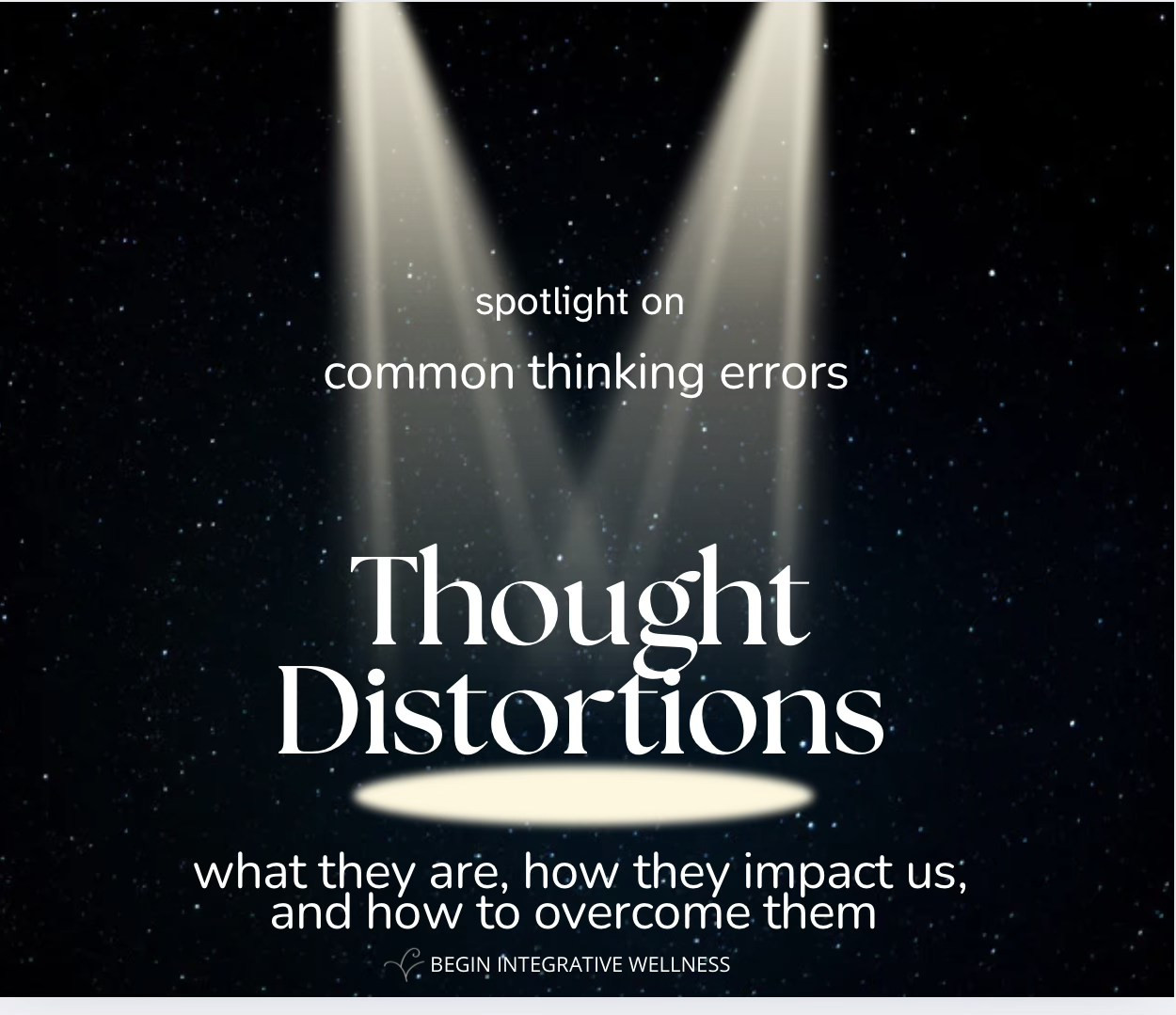
“The mind is a superb instrument if used rightly. Used wrongly, however, it becomes very destructive.”
— Eckhart Tolle
— Eckhart Tolle
What Are Thought Distortions—And Why Do We All Have Them?
Have you ever caught yourself:
- Spinning through a mental worst-case scenario,
- Assuming you know what someone else is thinking,
- Feeling certain your one mistake ruined everything?
Welcome to the very human experience of cognitive distortions—automatic, habitual ways our minds interpret events that feel real, but aren’t fully accurate.
Cognitive distortions are mental shortcuts formed over time. They’re fast, emotionally charged, and usually learned early—sometimes shaped by trauma, attachment dynamics, or repeated relational experiences. They’re also reinforced by the brain’s natural tendency to conserve energy and scan for threat.
In short: cognitive distortions are not a sign you’re broken or irrational.
They’re evidence that your brain is trying to protect you—just not always helpfully.
They’re evidence that your brain is trying to protect you—just not always helpfully.
Common Thought Distortions
Some familiar patterns you might recognize:
- All-or-Nothing Thinking: “If it’s not perfect, I’ve failed.”
- Catastrophizing: “If I speak up, everything will fall apart.”
- Mind Reading: “They didn’t text back—they must be mad at me.”
- Emotional Reasoning: “I feel unworthy, so I must be.”
- Personalization: “It’s my fault they’re upset.”
- Should Statements: “I should be better at this by now.”
Over time, these mental habits shape how we experience ourselves, our relationships, and even our capacity for growth.
Why They Stick: The Brain Science Behind Thought Distortions
Our brains are constantly processing information. When we’re calm and grounded, the prefrontal cortex helps us think rationally, regulate emotion, and make intentional decisions.
But under stress or emotional activation, the amygdala—our brain’s alarm system—takes over. It scans for danger and activates familiar mental patterns designed to protect us. Unfortunately, many of these patterns are outdated, exaggerated, or no longer useful.
This is how thought distortions become default neural pathways:
What fires together, wires together. And unless we consciously intervene, those wires become the lens we see life through.
What fires together, wires together. And unless we consciously intervene, those wires become the lens we see life through.
Mindfulness: The Tool That Helps You Step Back from the Story
Mindfulness doesn’t force you to “think positively.”
It teaches you to see clearly.
It teaches you to see clearly.
Practicing mindfulness allows you to:
- Slow down and observe your thoughts without judgment
- Notice when a distortion is present without merging with it
- Create space to choose a more grounded response
In fact, research from institutions like Harvard, UCLA, and Oxford shows that mindfulness:
- Reduces default-mode network activity (linked to rumination)
- Increases connectivity in the prefrontal cortex (associated with self-regulation)
- Lowers cortisol and improves emotional resilience
- Enhances cognitive flexibility—the ability to shift mental gears when needed
In other words, mindfulness helps us unhook from the inner narrator, so we’re not blindly believing every thought that passes through.
Try This: “Label the Lens”
Next time a strong reaction or thought pops up, try this three-step mindfulness check-in:
- Pause. Feel your feet. Breathe. Notice: “What just went through my mind?”
- Label the distortion. Is this catastrophizing? Mind reading? Black-and-white thinking?
- Gently disidentify. Try saying to yourself:
“I’m having the thought that...” or “Ah, there’s that old lens again.”
This simple naming can reduce the thought’s intensity, help you shift from reaction to reflection, and open a doorway to a more grounded view.
Ancient Wisdom Meets Modern Neuroscience
Spiritual traditions have long known what modern science now confirms:
Our thoughts are not always trustworthy.
Our thoughts are not always trustworthy.
In Buddhist psychology, the mind is called a "monkey mind"—restless, reactive, leaping from one assumption to the next.
In yoga philosophy, the practice of svadhyaya (self-inquiry) encourages regular reflection on the mind’s habits and the filters that shape perception.
What these traditions offer—backed now by neuroscience—is this insight:
Freedom doesn’t come from stopping your thoughts. It comes from no longer believing all of them.
Begin Again
You don’t have to get rid of your distortions to feel more free.
You just have to start noticing the lens you’re looking through.
You just have to start noticing the lens you’re looking through.
With time, mindfulness becomes more than a practice—it becomes a posture of self-awareness and compassion.
It helps you meet your thoughts like weather: passing, sometimes stormy, but not permanent—and not always predictive of reality.
✨ Want a visual companion to support this work?
I’ve created an easy to use, one page guide to Cognitive Distortions that will help you catch these sneaky thoughts in action. Click here to get a free copy!
📬 Subscribe for more science-and-soul wellness content
___________________
Begin Within
and align with the rhythm of nature and self.













0 Comments